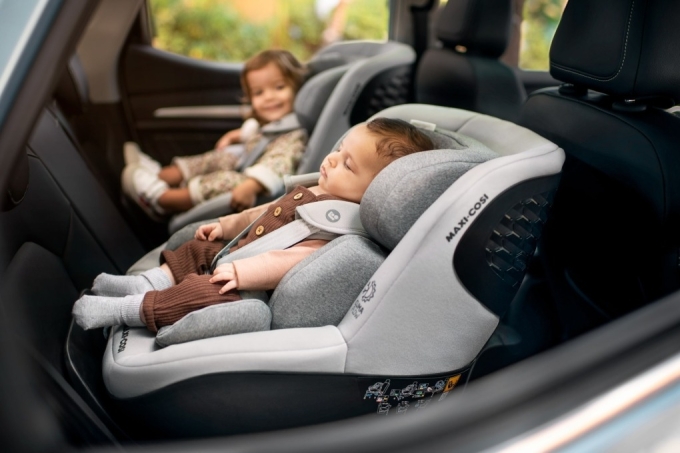The car was just right for his family of five in HCMC, with the children aged three to nine sitting in the back while he and his wife sat in front. But now, under the new Road Traffic Safety Law, the back seat cannot fit three child seats, Tung realizes.
“The law bans children from sitting in the front, and each child in the back must use a safety device, which means my car can now only fit two of them,” he says. “Does that mean the third one has to be transported by a motorbike behind us?”
He points out that a car is much safer than a motorbike, and so if safety is the real concern, it would make more sense to ban children from motorbikes entirely.
A family in Hanoi purchases a car seat worth VND6 million (US$228) for their child. Photo by VnExpress/Do Giang
Like Tung, many others are also unsure about how to adapt to the new car seat regulation that will take effect on Jan. 1, 2026. It states that children under 10 and less than 1.35 meters tall cannot sit in the same row as the driver and must use appropriate safety devices.
Although people support the law’s intent to enhance child safety, they are unsure about its practicality, especially in the case of families with multiple children or small cars. Some also say that with urban driving speeds averaging 20–30 km/h, the rule feels rigid and “unclear in its effectiveness” compared to the inconvenience it causes.
But Dr. Do Van Dung, former vice chairman of the HCMC Automobile and Power Association, dismisses the claims that “low-speed travel makes car seats unnecessary” and “a parent’s arms are the safest protection” for kids. He explains that when a car brakes suddenly or collides while traveling at a speed of 50 km/h, a 10-kg child can exert an impact force of 700–1,000 kg.
“No parent’s arms can withstand such force. The child will be thrown forward and hit the dashboard or windshield.”
He adds that using adult seatbelts, designed for people taller than 1.4 meters, for children can be even more dangerous, since they will run across their neck and stomach, increasing the risk of serious injury during impact.
Bui Tan Viet, 35, of HCMC says he learned this lesson after several near misses on family trips.
“A few times, when I braked suddenly, my son hit his head on the front seat even though he was being held. After that I decided to buy a child seat.”
At first his son resisted, but now he climbs into the seat on his own. Viet says he is looking for another seat suitable for his newborn.
Bui Tan Viet from HCMC, has used a child safety seat since his son was very young, so his son has become accustomed to it and cooperates well. Photo courtesy of Viet
Data from the U.S. National Highway Traffic Safety Administration shows that using car seats correctly can reduce the risk of death by up to 71% for infants. Besides, experts say, the market now has many solutions for the “small car, large family” issue. For children over four years old, booster seats, which are compact at around 10 cm thick, and cost around VND800,000 (US$30), can lift the child’s height to match the seatbelt properly. “Three booster seats can easily fit in the back row of a standard five-seater,” Dung says. Some multi-function seats can be adjusted to 10–12 height levels and used from infancy to age 12, avoiding the need to replace seats frequently.
Globally, it has almost always taken time to achieve changes to safety habits. Sweden spent 15 years promoting awareness to achieve nearly 100% compliance. The U.S. provided more than a decade of grace periods before enforcing penalties. In Europe, the i-Size standard for car seat transition lasted over 10 years (2013–2024).
Drawing from international examples, Dung suggests that Vietnam should provide a “buffer period” of three to five years to balance urgency with public readiness. Authorities should initially focus on public education and building free car seat installation and inspection centers in major cities, and begin with minor penalties for private cars in the second phase while exempting taxis and ride-hailing vehicles, he says.
The final phase should fully enforce penalties nationwide, coupled with subsidies and incentives for car manufacturers to include child seats in new cars, he says.
“Wise and compassionate implementation will turn car seats into an everyday safety habit, just like wearing helmets today.”
Subsidiary of VnExpress
License number: 71/GP-CBC, Ministry of Information and
Communications, September 22, 2021
Editor-in-Chief: Pham Van Hieu
Email: evne@vnexpress.netTel: 028 7300 9999 – Ext 8556
10th floor, Block A FPT Tower, 10 Pham Van Bach, Cau Giay Ward, Hanoi
© Copyright 1997 VnExpress.net. All rights reserved.












